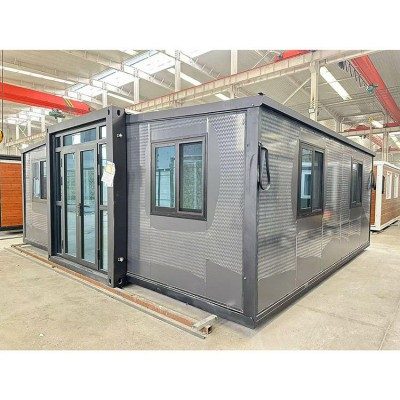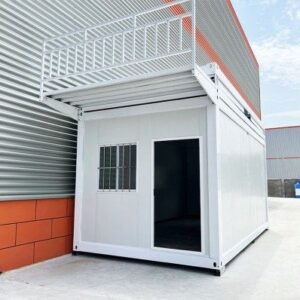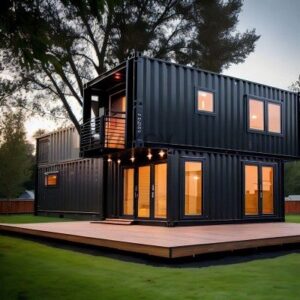When figuring how much is a container house, the size and finish level play a big role in pricing. Generally, container homes come in 20ft and 40ft sizes, with larger or multi-container setups costing more.
Typical Price Ranges by Container Size
- 20ft container homes usually start around $20,000 to $50,000 for a basic shell.
- 40ft container homes range roughly from $35,000 to $80,000 for a similar base setup.
- Modular or multi-container assemblies designed for larger living spaces naturally increase the price beyond those brackets.
Base Shell vs Fully Finished Container Homes
A base container shell includes the container itself with minimal modifications — basically the frame and walls. These are more affordable but require extra investment to make them livable.
A fully finished container home means it’s ready to move in:
- Insulated walls
- Plumbing and electrical systems
- Appliances and fixtures
- Interior finishes like flooring and cabinets
Fully finished models can cost 2 to 3 times more, generally pushing the price to $60,000 up to $150,000 or higher, depending on quality and customization.
Regional Price Differences and Influencing Factors
Container home prices also vary based on where you live in the United States:
- Urban areas with higher labor and permit costs typically mean higher prices.
- Remote or rural locations might lower costs for labor but could increase delivery and installation fees.
- Local building codes, demand, and land costs also affect the final price.
Understanding these regional factors early helps you budget realistically and avoid surprises during your container home project.
Main Factors Influencing Container House Costs
When figuring out container house costs, several key factors come into play that can significantly affect your overall budget. Understanding these will help you plan better and avoid unexpected expenses.
Container Shell Condition New vs Used
The condition of your shipping container shell is a big deal. New containers generally cost more upfront but require less repair and prep work, offering a cleaner start. Used containers are cheaper but might come with dents, rust, or chemical exposure that need fixing, which can add to your renovation costs.
Customization and Design Complexity
How much you want to customize your container home affects the price. Simple, single-container designs will be cheaper than multi-container assemblies with complex shapes or added architectural features. Adding windows, doors, or cutting walls means more labor and materials. Custom decks, roofing, or green features also raise costs.
Interior Finishes and Appliances
The quality of interior finishes makes a big difference:
- Basic plywood and standard fixtures keep costs low.
- Higher-end flooring, cabinetry, countertops, and appliances increase costs.
If you want built-in appliances or smart home features, expect the price to climb. Proper insulation and durable materials for long-term comfort and efficiency are also important and add to upfront costs.
Permits and Legal Fees
Don’t overlook permits and legal fees — these vary by region and can be pricey depending on your local building codes. Getting inspections and zoning approvals can add both time and money to your project.
Delivery Installation and Foundation Costs
Transporting a container home to your site isn’t always simple. Delivery fees vary based on distance and site accessibility. Once there, installation involves:
- Setting up a foundation (concrete slab, piers, or footings)
- Anchoring the container securely
Foundation costs depend on soil type and local requirements, and professional installation ensures safety and durability but adds to your budget.
Utilities Infrastructure Setup Plumbing Electrical HVAC
Getting utilities hooked up is another essential cost area:
- Plumbing for kitchens, bathrooms, and laundry
- Electrical wiring for lighting, outlets, and appliances
- HVAC systems for heating and cooling, especially in areas with extreme climates
These setups require licensed professionals and must meet code standards, influencing your container home construction cost significantly.
Cost Comparison Container Houses vs Traditional and Modular Homes
When deciding how much is a container house, it helps to compare costs with traditional and modular homes. Container houses often come with different pricing structures, and understanding these differences can help you decide what fits best in your budget.
Average Costs Per Square Foot Comparison
| Home Type | Average Cost Per Sq Ft (USD) |
|---|---|
| Container Houses | $100 – $200 |
| Traditional Homes | $150 – $300 |
| Modular Homes | $120 – $250 |
Container houses generally cost less per square foot than traditional homes. Their modular nature keeps construction quicker and cheaper. Modular homes fall in between—their factory-built components speed up building but still use conventional materials.
Benefits and Drawbacks of Container Houses in Pricing and Functionality
Benefits:
- Cost Efficiency: Reusing shipping containers helps lower material costs.
- Faster Build Time: Modular design cuts construction time, lowering labor expenses.
- Sustainability: Containers are recycled steel, which appeals to eco-conscious buyers and may qualify for incentives.
- Flexibility: Easy to modify and expand by adding containers.
Drawbacks:
- Customization Costs: Unique designs or luxury finishes can raise prices.
- Insulation Challenges: Metal requires high-quality insulation, adding to cost.
- Zoning and Permits: Some areas have restrictions or extra fees for container homes.
- Resale and Financing: Not all lenders or buyers are familiar with container homes, affecting resale value and loan options.
In short, container homes offer a more affordable and sustainable alternative with good flexibility, but may need careful budgeting for insulation and customization. Traditional homes might cost more but come with broader financing options and established market value, while modular homes strike a balance in both price and build speed.
Additional Costs to Consider for Container Houses
When planning your container house budget, it’s important to factor in several extra expenses beyond the initial build. These can add up quickly if overlooked, so here’s what to keep an eye on:
Remodeling and Maintenance Expenses
Even after your container home is built, remodeling or upgrading sections might be necessary. This can include changes to layouts or adding extra rooms. Plus, regular maintenance—like checking for rust, repainting, or repairing seals—keeps your home safe and efficient over time.
Insulation and Weatherproofing Costs
Shipping containers aren’t naturally insulated. To make your home comfortable year-round, you’ll need to invest in insulation and proper weatherproofing. This means adding materials like spray foam or panels to keep heat in during winter and out in summer. Good weatherproofing also protects against moisture and leaks, which are critical for durability.
Landscaping and Outdoor Adjustments
Your container home won’t exist in isolation. Landscaping—such as grading the land, planting, or building outdoor features—can improve curb appeal and usability. You might also need to create pathways, decks, or patios, which add to overall costs but enhance your living experience.
Transportation and Site Preparation Fees
Getting your container home to the site involves transportation costs that vary depending on distance and local regulations. Don’t forget about site preparation expenses. Preparing a foundation, clearing land, leveling, and setting up access roads are essential steps before installation and can influence your total budget.
By preparing for these additional costs, you’ll avoid surprises and ensure your container house is both comfortable and functional.
How to Budget for a Container House Cost
Creating a solid container home budget is key to keeping your project on track without overspending. Here’s a straightforward guide to help you plan your costs effectively while exploring container house financing options.

Step-by-Step Budgeting Guide for Container House Costs
- Estimate Container House Shell CostsDecide if you want new or used containers. New containers cost more but need less repair work. Used containers can save money upfront but might require more remodeling and compliance fixes.
- Add Customization and Interior FinishesFactor in expenses for insulation, windows, doors, flooring, and appliances. The more complex your design, the higher the costs, so keep your plans clear and realistic.
- Include Permits and Legal FeesBuilding permits and inspections are necessary. Check your local regulations early to avoid surprise fees.
- Calculate Delivery, Installation, and Foundation FeesContainer delivery isn’t cheap, especially if your site is remote. Foundation work and installation require specialized labor and equipment.
- Plan Utilities and Infrastructure SetupBudget for plumbing, electrical wiring, and HVAC systems since these costs add up fast.
Tips to Minimize Container Home Construction Costs Without Sacrificing Quality
- Simplify your design: Stick to one or two containers to save on structural and foundation costs.
- Buy used shipping containers: They are cheaper but inspect carefully to avoid hidden repairs.
- DIY some finishing work: Handling paint or basic interior work on your own can cut labor costs.
- Shop locally for materials and appliances: This reduces shipping fees and supports your community.
- Bundle services: Some contractors offer package deals covering design, permitting, and construction.
Financing Container House Options in the US
- Traditional loans: Banks and credit unions sometimes finance container homes but may require standard home loan qualifications.
- FHA and VA loans: These usually don’t cover container homes unless they meet specific criteria.
- Personal loans or home improvement loans: Flexible but often have higher interest rates.
- Grants and government programs: Look into local sustainability or alternative housing grants that may assist with funding.
- Manufacturer financing: Companies like Yichen offer financing plans tailored to container homes, which can simplify the process.
By following this container home budget guide, you can clearly map your expenses, avoid unexpected costs, and choose financing that fits your financial situation while investing in a durable, sustainable living space.
Where to Buy Container Houses Trusted Suppliers and Customization Options
When looking to buy a container house, choosing a trusted supplier is essential to ensure quality and reliability. One well-known manufacturer in the U.S. market is Yichen, recognized for offering a variety of shipping container homes that range from simple single-unit models to complex multi-container assemblies.
Yichen Container Houses and Customization Services
Yichen stands out because of its focus on customization—whether you want a ready-to-live-in container home or a modular design tailored to your specific needs. Their offerings include:
- Multiple sizes: 20ft and 40ft container options to fit different budgets and space requirements
- Turnkey solutions: Finished homes with appliances, insulation, and utilities installed
- Design flexibility: Ability to modify layouts, add rooms, and select interior finishes
- Professional project support: Guidance through permits, installation, and connection of utilities
Other Options for Buying Container Homes
In addition to manufacturers like Yichen, the following platforms can be good places to explore and purchase container homes:
- Online marketplaces: Websites like Prefab Container Homes, Container Homes USA, and Etsy for custom builds or kits
- Local showrooms: Some regions have local dealers or builders specializing in container homes where you can see models firsthand and discuss customization
- Used container sales: For cost savings, buying used shipping containers from scrap yards or resellers allows for a DIY approach or builder collaboration
What to Look for When Choosing a Supplier
- Experience and reputation: Look for suppliers with verified projects and strong customer reviews
- Customization options: The ability to tailor interiors, exteriors, and systems to fit your needs and local codes
- Delivery and installation: Check if they offer shipping container home installation fees and foundation services
- Post-sale support: Maintenance advice, warranty coverage, and customer service availability
Real-Life Container House Cost Examples and Case Studies
Looking for real-world container house prices and what you get for your money? Here are some recent project snapshots and customer stories that highlight typical costs and satisfaction levels.
Example Projects and Costs
- 20-Foot Single Container Home
- Cost: $25,000–$40,000
- Details: Basic shell with essential finishes, simple plumbing, and electrical setup. Ideal for a tiny home or office space.
- Outcome: Quick build, affordable entry to container home living, popular for DIY enthusiasts.
- 40-Foot Fully Finished Container House
- Cost: $60,000–$100,000
- Details: Includes premium interior finishes, full kitchen and bathroom, modern appliances, HVAC, and soundproofing. Perfect for a small family.
- Outcome: Solid investment, higher comfort level, often preferred for primary residences or vacation homes.
- Multi-Container Assembly (3 to 5 Bedroom)
- Cost: $150,000–$300,000+
- Details: Customized layouts with advanced design complexity, landscaping, foundation, and complete utility hookups. Comparable to modest traditional homes.
- Outcome: Excellent for larger families or those wanting spacious, eco-friendly housing.
Why These Examples Matter
Understanding how container home costs break down in real cases helps set realistic expectations. By reviewing these examples, you can see:
- How container size and customization impact total price
- The balance between upfront investment and long-term benefits
- The diversity in costs depending on features and location
For more detailed options and cost breakdowns, check out Yichen’s offerings, including flat-pack and expandable container houses, to find the right fit for your budget

